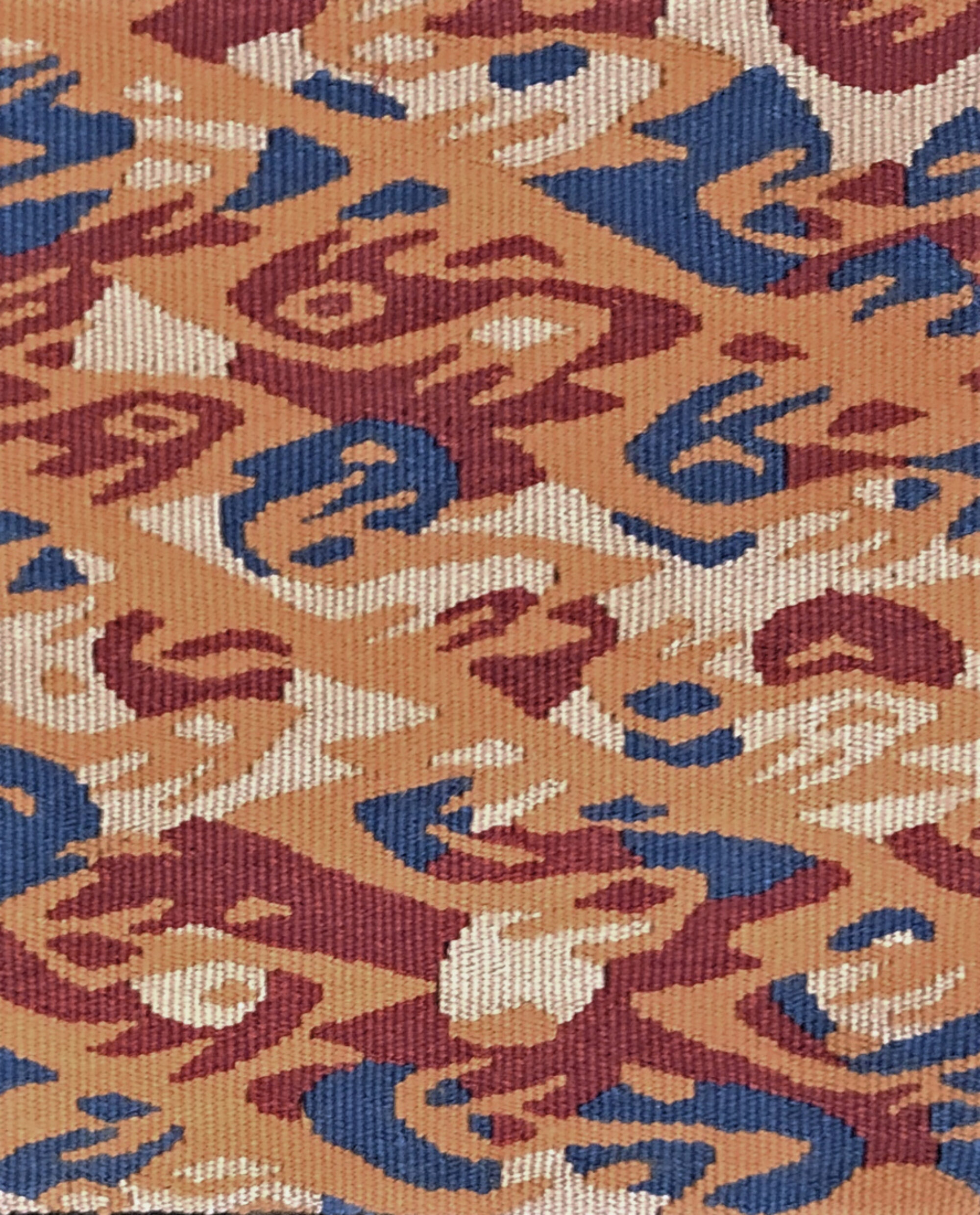This article was first published in the International Tapestry Journal, Vol. 3 No. 2, Summer 1997.
Depicting the female body is fraught with tension. Revisionist art history constantly reminds us of art’s complicity in producing an idealized woman who supplies the Other against which masculinity is defined- the mirror in which the male gaze narcissistically reflects back upon itself.1 Underlying this critique is poststructuralism’s assertion that images do not bear a transparent, neutral relationship to their model, but rather interpret that model according to the cultural ideology of their maker. In this view representation positions people within a hierarchical system, resulting in relationships in which those who represent (and thus define) have power over those they represent.2
The task for those who wish to question the types that have been constructed as normal and desirable, is to develop alternative ways of knowing women. Some artists, such as Mary Kelly, have refused to picture women at all, using text instead to redefine out understanding of women’s experience. Others, notably Cindy Sherman, have parodied stereotypes in order to draw attention to their contingent and constructed nature.3 In order to look more closely at some of the issues involved in the representation of gender I wish to examine the work of Christine Laffer, in particular four pieces from her MFA thesis exhibition, Curious Fears , in which the artist offers us, through drawings and tapestries, images of both female and male.
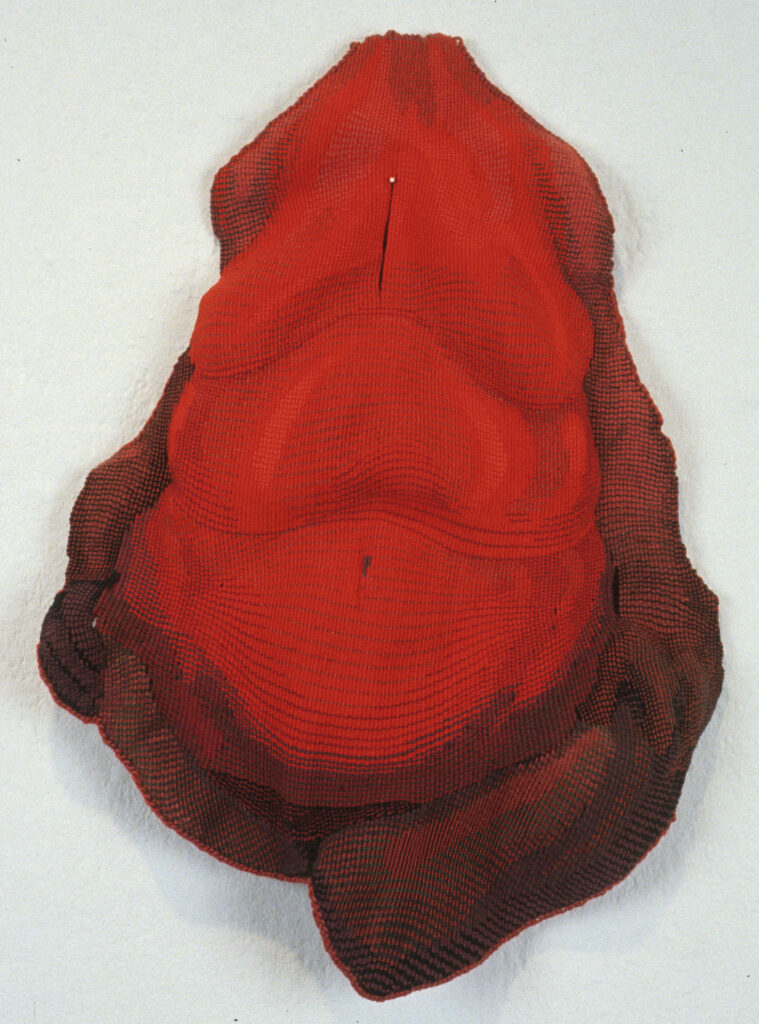
Laffer’s representations of women, including the tapestry A Warm Resistance and the drawing Layered Swimsuit and Meat , concentrate, in almost a fetishistic way, on the materiality and flesh of the female body. Eschewing the ideal of the lean fashion model, these bodies display their voluptuous, cascading flesh in a way that Rubens might have appreciated. The careful drawing and modeling reveals the physicality of the body but also abstracts it – the rolling, bulging flesh becomes graceful curves and illuminating shadows. The medical or social consequences of what some consider a disease do not taint the beauty of these forms.
Both of these images focus on the female torso. Feminist scholars have pointed out that Western culture connects women to nature, opposing it to masculine culture. This dichotomy, which is a legacy of the Enlightenment, is accompanied by many binary corollaries, including that of the body and mind, intuition and intellect and the irrational and rational.4 Laffer’s reduction of the women’s heads calls attention to this cultural duality. The artist’s motives – pointing out the cultural tendency to value women only for their bodies and/or celebrating the materiality of female flesh- can only be considered in light of her depictions of the male body, which will follow shortly.
The title, A Warm Resistance , suggests both the flesh of the body and also the resistance to cultural standards that favor thin females. The truncated torso demands that we focus our attention on the breasts and belly, reminding us of women’s procreative role, a role which has been central in psychology’s association of women with nature, and which often leads to a maturity that denies its owner a place in the world of ideal female form. The unruliness of this body and the unabashed way it is presented ask us to question our preconceptions about the female body. Yet, there seems to be a certain ambiguity in the artist’s treatment. The bodies are excessive, in some cases appearing malformed and difficult to fit into our understanding of human anatomy. But the classical rendering, which emphasizes abstraction, suggests a beauty of form that underlies this unrestrained display of flesh. The tension between these two understandings suggests the struggle that many of us share in our feelings about body size.
A Warm Resistance is a shaped tapestry whose eccentric weft and woven shading create both the illusion of three dimensionality and actual dimensionality. The fabric bulges and puckers, rising out of the flatness of the wall, defying traditional definitions of tapestry. The combination of classical color blending techniques and a distorted tapestry fabric seems to ask us to reassess not only our cultural preconceptions of the female body, but also the very category of tapestry. This alliance between form and content strengthens the effect of Laffer’s work.
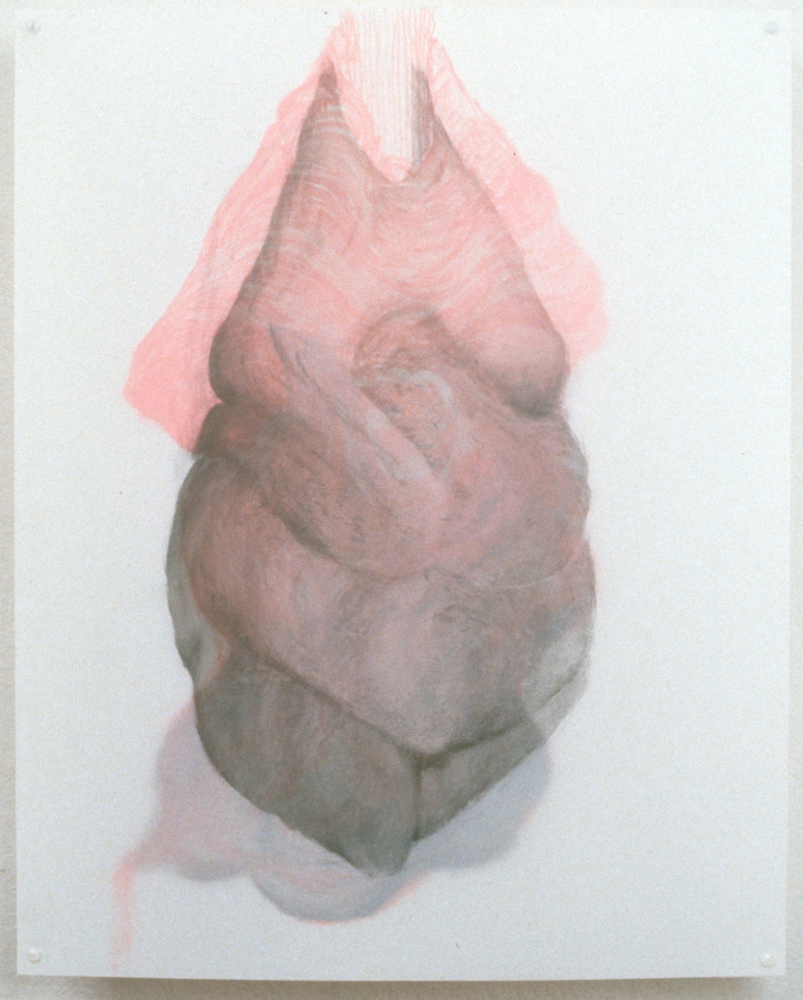
Layered Swimsuit and Meat consists of two drawings, one superimposed over the other. The transparency of the drawings contrasts with the dense solidity of the woven forms, suggesting a more open ended relationship between form and content. The intermixing of the visceral, probably dead flesh and a female swimsuit suggests a disquieting connection between women’s bodies and the commodification of animal flesh.
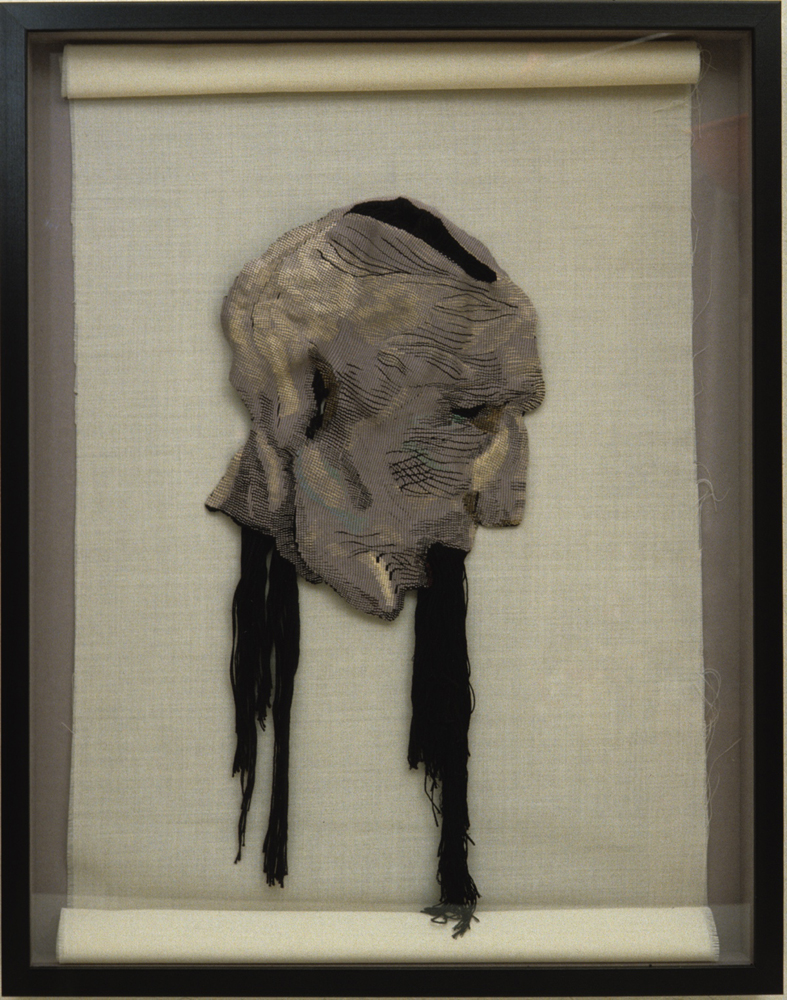
The male gender is represented in Laffer’s show by Collapse , a woven head crisscrossed by a web of lines. One might be tempted to see in these lines the linear shading techniques characteristic of tapestry, and indeed areas of darkness and light arise, but this is not the careful modeling found in the female bodies, in which the shading is subtle and follows closely the contours of the fabric, and by extension, the body. These lines are bold and erratic, breaking down planes of the face by crossing from high points to low points, exerting a nervous independence that defies our attempts to link it to the imagined three dimensional form. These lines are more like scars, marking the face of an obviously troubled being.
The orifices of the head are black, suggesting a sinister, perhaps empty form. The warp cascades out of the mouth ejecting the actual structure of the woven form. Is this tangled web emitting from the mouth, language, the vehicle of the intellect and reason, our source of meaning? If so, meaning seems to be lost in an unsolvable maze and one is forced to think of this great human achievement as a kind of regurgitation.
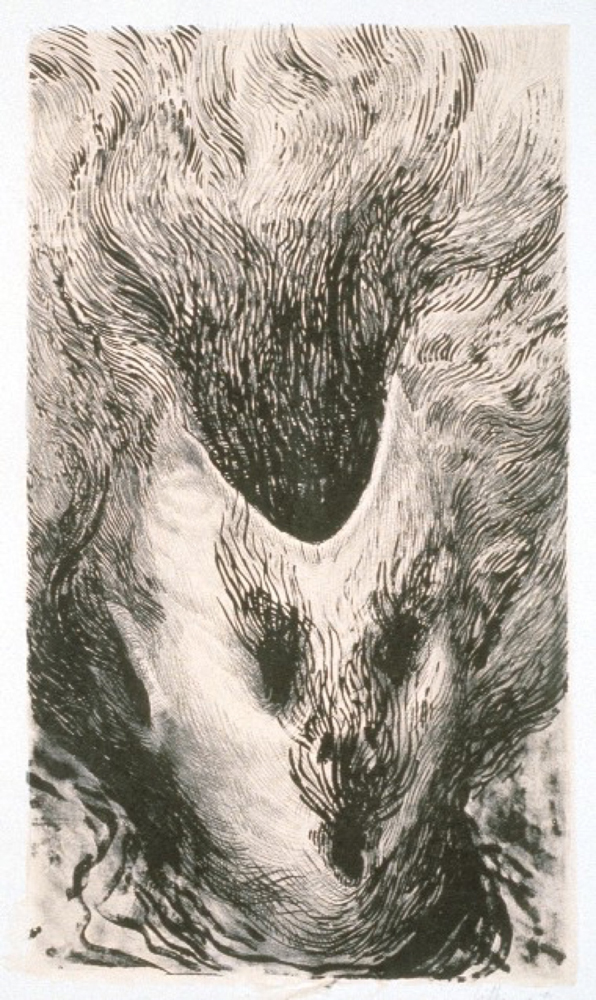
It would be tempting to contrast this male head with the female bodies in terms of the Enlightenment gender dichotomies of mind/body and culture/nature, however, Laffer’s work will not submit to such an easy conclusion. For when we look further we find another head, a print entitled An Excess of Nothing , with similar connotations. In this image the visceral contents of the head, or perhaps the psyche, are streaming out of every orifice. The fine and dense network of lines creates a disturbing, even horrifying, vision. The empty black eyes suggest that this body has no soul. It is a void, a container which has lost as much as Laffer’s female torsos suggest they hold. The frenzied drawing and the surreal image offer a strong contrast to the carefully rounded and modeled forms of the female bodies.
The similarities with the tapestry Collapse suggest we label this figure male, and yet, the artist informs us, it is female. Apparently the mind, culture, reason and intellect that are normally ascribed to the male gender can also exist and disintegrate in women. This is indeed troubling. The stable, coherent self of the Enlightenment which has clearly lost its intellectual identity and is merging with its environment has also lost its gender. Perhaps we are not as neatly defined and known as some would hope. Perhaps even the cultural dichotomy of gender has broken apart.
Laffer’s combination of the female torsos and male/female heads5 offer a striking contrast. The artist’s images not only trouble the value ascribed to particular body forms and the gendering of attributes but also challenge the very notion of a stable, gendered self. The speaking subject is dissolving, whether male or female, and with that goes the discursive formation of gender. Yet, these disjunct forms do not offer a stable alternative. If women are nothing more than overflowing bodies and both men and women nothing more than disintegrating intellects, things are dark indeed. We must ask how the body joins to the head, how the body/mind, nature/intellect dichotomies will be resolved in order to offer a new kind of subjectivity. After the disintegration of cultural gender types, how can we construct our selves in a new way which affirms difference without implying value? Are we left to despair or are there creative, subversive possibilities for alternative expressions and subjectivities?
End Notes
1 Much of the writing regarding the psychological role of women as a foil to men comes out of the writing of Freud, Freud’s interpretation in the writings of Lacan, [esp. “The Meaning of the Phallus” translated in Feminine Sexuality: Jacques Lacan and the Ecole Freuduenne, eds. Juliet Mitchell and Jacquelline Rose (New York: Norton, 1985) and the many texts that discuss Lacan’s work. The way in which the notion, sex, has been understood throughout the history of Western culture has been taken up by Michel Foucault in The History of Sexuality (New York: Vintage, 1980). For a close scrutiny of some of the ideas that have surfaced from these seminal texts and the ways in which they have been understood on other’s writings, see Judith Butler, Gender Trouble: Feminism and the Subversion of Identity (New York: Routledge, 1990). The notion of the male gaze was developed by Laura Mulvey in her seminal text, “Visual Pleasure and Narrative Cinema” Screen 16, no. 3 (Autumn 1975).
2 For an excellent discussion of the relationship between representation and power, see Craig Owens, Beyond Recognition: Representation, Power and Culture (Berkeley: University of California Press, 1992). Owens’ chapter title, “The Indignity of Speaking for Others,” sums up a prevailing attitude in intellectual circles that has radically affected the practice of anthropology, history and most of the social sciences. A classic text in this area is James Clifford, The Predicament of Culture: Twentieth Century Ethnography, Literature and Art) (Cambridge: Harvard University Press, 1988).
3 Darcy Grimaldo Grigsby offers a succinct overview of some of the ways in which women have chosen to challenge the picturing of women, both through critique and through alternative representations in “Dilemmas of Visibility: Contemporary Women Artists’ Representations of Female Bodies” in The Female Body: Figures, Styles and Speculations, ed. Laurence Goldstein (Ann Arbor: The University of Michigan Press, 1991).
4 The questioning of the rational, stable self, capable of objective thought that reveals a non biased “truth,” has been one of the most complex and far reaching consequences of the feminist and postmodernist deconstructive impulse. Jane Flax discusses these issues and the relation between feminism and postmodernism in “Postmodernism and Gender Relations in Feminist Theory” in Feminism/Postmodernism, ed. Linda J. Nicholson (new York: Routledge, 1990).
5. I label them such here, for apparently I am not the only viewer who has been tempted to call the female heads male. Communication with the artist, April 5, 1997.
